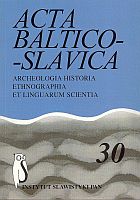Nazwy stopni pokrewieństwa w polszczyźnie łotewskiej
The Names of Degrees of Relationship in the Polish Dialect of Latvia
Author(s): Małgorzata OstrówkaSubject(s): Language and Literature Studies
Published by: Instytut Slawistyki Polskiej Akademii Nauk
Keywords: Latvia; the Polish language in Latvia; degrees of relationship
Summary/Abstract: The purpose of the work is to present the names of degrees of relationship within family that are used in the active layer of the lexicon of Poles in Latvia as well as to find whether, and if so, to what degree, those names differ from the names that function in the general contemporary Polish language. The material was analysed by applying a number of methods: 1. defining the designation and studying of names referring to it, 2. defining the name and studying the designations that it designates. Also, the cognitive approach was applied – diachronic findings that referred to the Polish language and Baltic and Eastern Slavonic languages were compared to synchronic ones, and those in turn were compared to the findings of research in Latvia. Thus each entry in the study is bi-bipartite – at first, a short etymology of the name is given, next examples from the Latvian Polish are given together with the context and, inasmuch as it is possible, their Baltic (Lithuanian, Latvian, Latgalian) and Eastern Slavonic equivalents follow. The work includes also the basic entries from the dictionary for the degrees of relationship (for instance, pokrewieństwo rodzinne [same blood -family relationship], powinowactwo rodzinne [spouse originating family relationship], pokrewieństwo pełne i niepełne[full and partial family relationship]), as well as features associated with the names of degrees of relationship (relativism, correlativism, supletivism, constancy, and universality). The analysis brings forth the following conclusions: the names of family relationships that are in use among Poles in Latvia are in most cases identical with those used in the general Polish; sometimes phonetic differences occur (for example, pronunciation of the soft l in every position – [’adul’a, semi-soft consonants s’, z’, c’, [’) , also some morphological differences occur (for instance, the ending of Instrumentalis singularis z mamoj instead of z mamą ); · some of them are innovations introduced to the Polish language under the Eastern Slavonic influence – dziadzia in place of wujek [uncle], stryj, przyjaciel rodziny, plemienik, plemienica to mean bratanek [brother's son], bratanica [brother's daughter], siostrzeniec [sister's son], siostrzenica [sister's daughter], papa – in lieu of tata; · most of those names constitute the common Indo-European heritage – from the domain of the tribal period based on matriarchal system the following names are derived: matka [mother], ojciec [father], brat [brother], syn [son]; and others, such as: dziecko [child], rodzice [parents] dziadkowie [grandparents] and pradziadkowie [great grandparents] come from later periods, hence difference between the roots of Polish names and, for instance, Lithuanian or Latvian names . In order to obtain the full description how the names of relationship function in Latvia, more detailed questionnaire study is needed.
Journal: Acta Baltico Slavica
- Issue Year: 2006
- Issue No: 30
- Page Range: 453-469
- Page Count: 17
- Language: Polish

